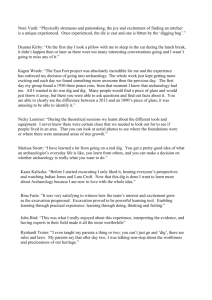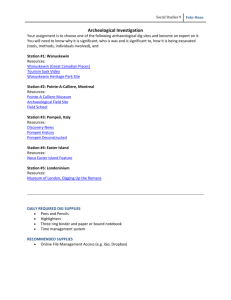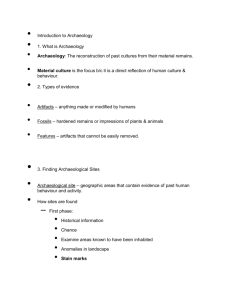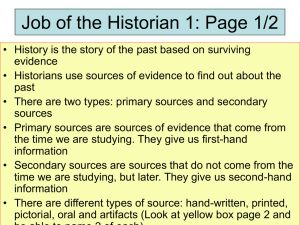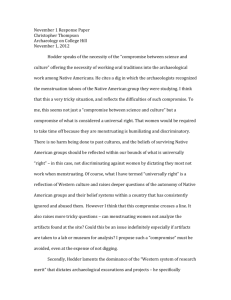Soc9 EricaNotes
advertisement
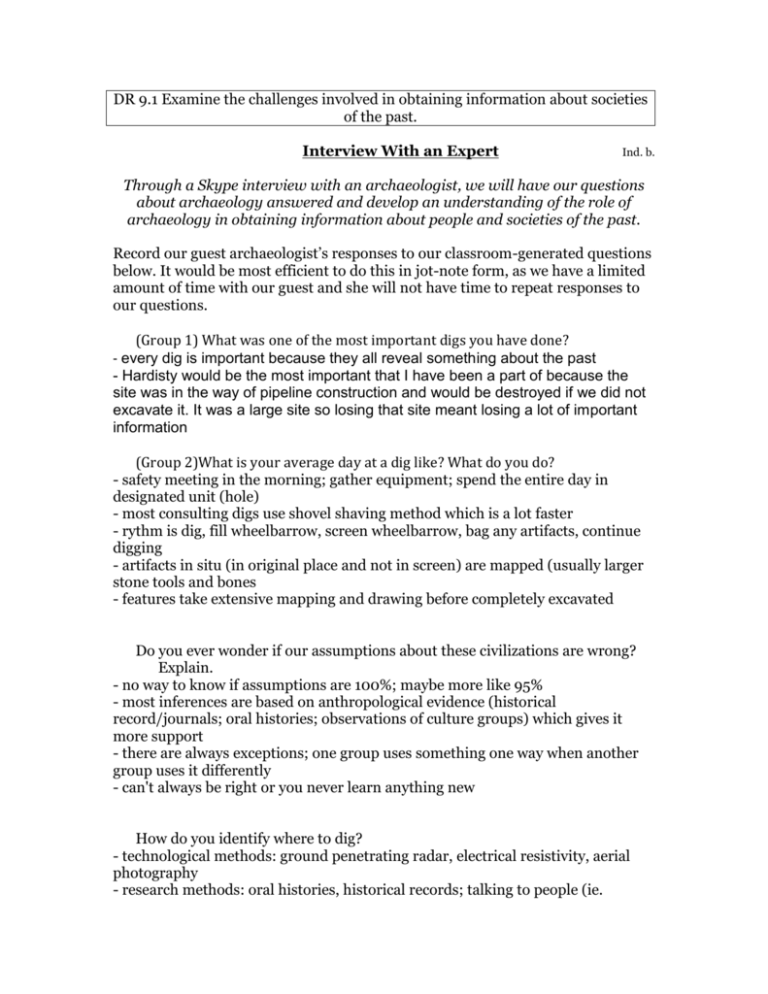
DR 9.1 Examine the challenges involved in obtaining information about societies of the past. Interview With an Expert Ind. b. Through a Skype interview with an archaeologist, we will have our questions about archaeology answered and develop an understanding of the role of archaeology in obtaining information about people and societies of the past. Record our guest archaeologist’s responses to our classroom-generated questions below. It would be most efficient to do this in jot-note form, as we have a limited amount of time with our guest and she will not have time to repeat responses to our questions. (Group 1) What was one of the most important digs you have done? - every dig is important because they all reveal something about the past - Hardisty would be the most important that I have been a part of because the site was in the way of pipeline construction and would be destroyed if we did not excavate it. It was a large site so losing that site meant losing a lot of important information (Group 2)What is your average day at a dig like? What do you do? - safety meeting in the morning; gather equipment; spend the entire day in designated unit (hole) - most consulting digs use shovel shaving method which is a lot faster - rythm is dig, fill wheelbarrow, screen wheelbarrow, bag any artifacts, continue digging - artifacts in situ (in original place and not in screen) are mapped (usually larger stone tools and bones - features take extensive mapping and drawing before completely excavated Do you ever wonder if our assumptions about these civilizations are wrong? Explain. - no way to know if assumptions are 100%; maybe more like 95% - most inferences are based on anthropological evidence (historical record/journals; oral histories; observations of culture groups) which gives it more support - there are always exceptions; one group uses something one way when another group uses it differently - can't always be right or you never learn anything new How do you identify where to dig? - technological methods: ground penetrating radar, electrical resistivity, aerial photography - research methods: oral histories, historical records; talking to people (ie. farmers) about their land - walking around --> basic pedestrian surveys looking for landmarks/features -> mound of rocks may be a collapsed chimney -> large shallow pit may have been a cellar -> through experience you learn how to identify sites with your eyes - environmental factors: people need shelter, water, food....is there water nearby, is there materials to build a shelter, is there a steady food source? (Group 1) How can you tell when something happened and how it happened? - dating methods can vary: radiocarbon dating; dendrochronology; stratigraphy - use projectile point styles to develop a chronology that can be helpful when dating a site - environmental changes can be seen in the soil (ie. expansion of riverbeds based on gravel/stone buildup; Ice Ages) - how something happened is harder to tell without being there - natural progression of civilization?? developing from mobile hunter/gatherers into sedentary agriculturalists; interaction with other culture groups through evidence of trade (ie. pottery styles) - use of tools can be inferred based on historical records/anthropological observations/ oral histories (Group 2) What is the biggest challenge while you are digging at your sites? - time is usually the biggest challenge - can you dig up enough of the site to provide you with sufficient information to make an accurate interpretation of the site? - consulting jobs are on a strict schedule with construction of pipelines, etc. so we need to be in and out as quickly as possible - weather can interfere with a dig (rain, heat, cold) and make it take longer - will you have a change to come back to the site next season, or is this your only chance? How long do you take to dig in a site? - depends on the size of the site and density of the artifacts - a large site (Hardisty) can take several seasons - sites being excavated for educational/research purposes can also take several seasons or be an ongoing excavation (South Branch House 8 years) - a lot of artifacts/features means longer; number of people digging has an effect - Hardisty rotated around 35 people through the season and excavated a huge area - South Branch House had 3 archaeologists and only excavted 5 1m x 1m units Have you ever found something out of the ordinary? What was it? - nothing really extraordinary -South Branch House (north and south) - south was thought to be attacked and burned but ash was also found in the north part of the site which suggests burning there as well ---- don't know if it was accidental or the result of an attack What kinds of specialists do you work with at your digs? - multidisciplinary job - geologists, environmental specialists, anthropologists, animal behavouralists, plant specialists - within archaeology; specialize in bones (human or animal), stone tools (points), pottery, historical/precontact What is the purpose of your work? - preserve and interperet the past - learn about how people lived in the past, how they evolved in to the civilizations we are today, what can we learn from the past (learn from our mistakes) - preserve the past to share it with people of the future; once it's gone then it is gone forever What is it like to find the artifacts that you have? - it's an amazing feeling - this is an item that no one has seen or touched for hundreds or thousands of years and I am the first one to see it What do you find most interesting about archaeological digs? - making assumptions about how people lived in the past - trying to understand how people thought in the past/how they made decisions to do what they did (make stone tools, create pottery, begin trading with other culture groups) - how people evolved from being mobile hunter/gatherer groups to sedentary agriculturalists At what site did you find the most artifacts or features? - Hardisty for sure--largest site; bison processing site so there were lots of boiling pit/hearth features and lots of dense bone beds; that means lots of artifacts - last report I saw said over 35,000 artifacts and they're still digging What was your most interesting find? - Ring from South Branch House -- belonged to someone at one time and it was lost....only to be found 500 years later - Birch bark pouch at South Branch House -- organic material would usually disintegrate in the earth, but this didn't - first point from Wanuskewin -- always exciting to find your first point What is your favourite part of the job? - finding artifacts is always exciting, especially after finding nothing for a while - knowing that I am helping to preserve an important part of our heritage...how else do you learn about where you came from What was the oldest thing you found at a dig site? - Hardisty dates from 1500 to 7000/8000 years BP - Wanuskewin "Wolf Willow" dates up to 6000 years BP How old were you when you decided to become an archaeologist and why did you choose the career? - around 20 years old - always had a love of history - university classes helped me decide; the professors were awesome; the idea of uncovering history and being a part of preservation was something I liked How well does archaeology pay? - depends on the job and your level of experience - academic archaeology can pay from $12-$15 an hour - consulting archaeology has a couple levels based on education and experience - Jr arch. (out of uni. to around 4/5 years experience without a Master's) $18-$25 an hour - Sr arch. (5+ years experience or Master's with ability to hold permit) $25-$30 an hour Have you ever lost artifacts due to bad weather or some other conditions? Explain. - South Branch House was located on a riverbank so erosion has washed part of the site away - Hardisty was in the right of way for a pipeline so once we were done, it was destroyed by construction. Anything left over was gone. What was your favourite site? Why? - every site I've worked at has been a favourite - I lean more towards historical archaeology so I'd have to say South Branch House and Bonnieville were favourites - Hardisty and Wanuskewin were equally interesting pre-contact sites so they were enjoyable as well What was the scariest thing you’ve dug up? Explain. - nothing scary - unlikely to come across human remains so there is no danger there - human remains means shutting down the site to allow for a legal investigation; if the remains are not "modern" (ie. murder victim) then the dig can continue only once a connection to a local culture group has been made and the body has been moved to a proper burial ground - battlefield archaeology would uncover ammunition/explosives that are still active What dig site do you want to go to next? Why? - archaeology in Europe (battlefield sites; concentration camp archaeology) - Pompeii (city covered by volcanic ash encased everything in pristine condition) - human body cavities What kind of training do you need to become an archaeologist? - 4 years of university would get you a degree - another 4-8 years would get you a Master's degree, which will allow you to hold a permit at a dig site (that is to let you be a site supervisor) - most consulting companies want you to be able to hold a permit so they would prefer that you have your master's degree What was the most valuable thing found at a dig site you were at? - nothing valuable $$$ wise - everything has value in regards to information; everything means something to an archaeologist and we usually do not consider the dollar value of an artifact - in the past some artifacts were sold to collectors (Egypt) but work is going on to recover those items and have them returned to their rightful place What is the hardest part about your job? - the physical work is the hardest part (early mornings, manual labour digging and screening) very physically demanding job - always out in the elements (hot days/ cold days, rain or shine) - time consuming work; there's lots of paperwork that has to been done when you are in the process of digging; significant artifacts need to be mapped, which can take time (days) when it is something like a feature What do you wear when you are working? - on a consulting job you require safety gear (hard hat, safety glasses, reflective vest, gloves, steel-toe boots 6 to 8 inch ankle, heavy pants) - weather gear (rain coat, hats, sweaters, etc.) How long have you been studying archaeology for? - 6 years - I haven't been to a dig site for a couple years now with my new career - always stay in touch with friends to know what is going on in the field and in research What kind of archaeology do you do? - I've worked on a variety of sites - historical (Bonnieville: farmstead and South Branch House: fur trade fort) - precontact (Wanuskewin: occupation site and Hardisty: processing site) - historical archaeology would be my preference
